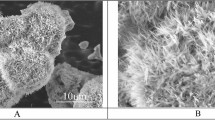Abstract
This work investigates how functionalization of aluminium surfaces with natural type III Anti-Freeze Protein (AFP) affects the mechanism of heterogeneous ice nucleation. First the bulk ice nucleation properties of distilled water and aqueous solution of AFP were evaluated by differential scanning calorimetry. Then the modified surface was characterized by Secondary Ions Mass Spectroscopy (SIMS), Fourier Transform InfraRed (FTIR) spectroscopy and contact angle measurement. Freezing experiments were then conducted in which water droplets underwent a slow controlled cooling. This study shows that compared to uncoated aluminium, the anti-freeze proteins functionalized surfaces exhibit a higher and narrower range of freezing tempera-ture. It was found that these proteins that keep living organisms from freezing in cold environment act in the opposite way once immobilized on surfaces by promoting ice nucleation. Some suggestions regarding the mechanism of action of the observed phenomena were proposed based on the Classical Nucleation Theory (CNT).
Similar content being viewed by others
References
Angell C A. Supercooled water. Annual Review of Physical Chemistry, 1983, 34, 593–630.
Matsumoto M, Saito S, Ohmine I. Molecular dynamics simulation of the ice nucleation and growth process leading to water freezing. Nature, 2002, 416, 409–413.
Page A J, Sear R P. Freezing in the bulk controlled by pre-freezing at a surface. Physical Review E, 2009, 80, 1–5.
Sear R P. Nucleation: Theory and applications to protein solutions and colloidal suspensions. Journal of Physics: Condensed Matter, 2007, 19, 1–28.
Zachariassen K E, Kristiansen E. Ice nucleation and antinu-cleation in nature. Cryobiology, 2000, 41, 257–279.
Cheng C H. Evolution of the diverse antifreeze proteins. Current Opinion in Genetics & Development, 1998, 8, 715–720.
Yeh Y, Feeney R E. Antifreeze proteins: Structures and mechanisms of function. Chemical Reviews, 1996, 96, 601–618.
Baardsnes J, Davies P L. Contribution of hydrophobic residues to ice binding by fish type III antifreeze protein. Biochimica et Biophysica Acta, 2002, 1601, 49–54.
Fletcher G L, Hew C L, Davies P L. Antifreeze proteins of teleost fishes. Annual Review of Physiology, 2001, 63, 359–390.
Jia Z, Deluca C I, Chao H, Davies P L. Structural basis for the binding of a globular antifreeze protein to ice. Nature, 1996, 384, 285–288.
Yang C, Sharp K A. The mechanism of the type III antifreeze protein action: a computational study. Biophysical Chemis-try, 2004, 109, 137–148.
Garnham C P, Campbell R L, Davies P L. Anchored clathrate waters bind antifreeze proteins to ice. Proceedings of the National Academy of Sciences, 2011, 108, 7363–7367.
Nutt D R, Smith J C. Dual function of the hydration layer around an antifreeze protein revealed by atomistic molecular dynamics simulations. Journal of the American Chemical Society, 2008, 130, 13066–13073.
Mossop S C. The nucleation of supercooled water by various chemicals. Proceedings of the Physical Society, 1955, 69, 165–174.
Sarkar D K, Farzaneh M. Superhydrophobic coatings with reduced ice adhesion. Journal of Adhesion Science and Technology, 2009, 23, 1215–1237.
Jafari R, Menini R, Farzaneh M. Superhydrophobic and icephobic surfaces prepared by RF-sputtered polytetra-fluoroethylene coatings. Applied Surface Science, 2010, 257, 1540–1543.
Jung S, Dorrestijn M, Raps D, Das A, Megaridis C M, Poulikakos D. Are superhydrophobic surfaces best for icep-hobicity? Langmuir, 2011, 27, 3059–3066.
Esser-Kahn A P, Trang V, Francis M B. Incorporation of antifreeze proteins into polymer coatings using site-selective bioconjugation. Journal of the American Chemical Society, 2010, 132, 13264–13269.
Takmakov P, Vlassiouk I, Smirnov S. Application of anodized aluminum in fluorescence detection of biological species. Analytical and Bioanalytical Chemistry, 2006, 385, 954–958.
Scott A, Gray-Munro J E. The surface chemistry of 3-mercaptopropyltrimethoxysilane films deposited on magnesium alloy AZ91. Thin Solid Films, 2009, 517, 6809–6816.
Wood G R, Walton A G. Homogeneous nucleation kinetics of ice from water. Journal of Applied Physics, 1970, 41, 3027–3036.
Mastai Y, Rudloff J, Cölfen H, Antonietti M. Control over the structure of ice and water by block copolymer additives. ChemPhysChem, 2002, 3, 119–123.
Mitsuiki M, Mizuno A, Tanimoto H, Motoki M. Relation-ship between the antifreeze activities and the chemical structures of oligo- and poly(glutamic acid)s. Journal of Agricultural and Food Chemistry, 1998, 46, 891–895.
Baruch E, Belostotskii A M, Mastai Y. Relationship between the antifreeze activities and the chemical structures of polyols. Journal of Molecular Structure, 2008, 874, 170–177.
Kimizuka N, Viriyarattanasak C, Suzuki T. Ice nucleation and supercooling behavior of polymer aqueous solutions. Cryobiology, 2007, 56, 80–87.
Charpentier T V J, Neville A, Millner P, Hewson R W, Morina A. Development of anti-icing materials by chemical tailoring of hydrophobic textured metallic surfaces. Journal of Colloid and Interface Science, 2013, 394, 539–544.
Seeley L H, Seidler G T. Two-dimensional nucleation of ice from supercooled water. Physical Review Letters, 2001, 87, 1–4.
Turnbull D, Vonnegut B. Nucleation catalysis. Industrial & Engineering Chemistry, 1952, 44, 1292–1298.
Seeley L H, Seidler G T. Preactivation in the nucleation of ice by Langmuir films of aliphatic alcohols. Journal of Chemical Physics, 2001, 114, 1046–1047.
Liedberg B, Hederos M, Konradsson P, Borgh A. Mimicking the properties of antifreeze glycoproteins: Synthesis and characterization of a model system for ice nucleation and antifreeze studies. Journal of Physical Chemistry B, 2005, 109, 15849–15859.
Kobashigawa Y, Nishimiya Y, Miura K, Ohgiya S, Miura A, Tsuda S. A part of ice nucleation protein exhibits the ice-binding ability. FEBS Letters, 2005, 579, 1493–1497.
Author information
Authors and Affiliations
Corresponding author
Rights and permissions
About this article
Cite this article
Charpentier, T.V.J., Neville, A., Millner, P. et al. An Investigation of Freezing of Supercooled Water on Anti-Freeze Protein Modified Surfaces. J Bionic Eng 10, 139–147 (2013). https://doi.org/10.1016/S1672-6529(13)60208-5
Published:
Issue Date:
DOI: https://doi.org/10.1016/S1672-6529(13)60208-5




